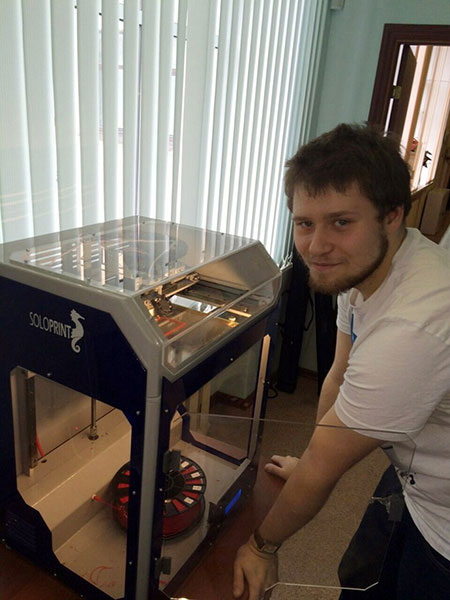We Keep Pace Polytechnic University Alumni have Created the First Russian 3D-Printer
Alexandr Sosnovskih, who is the founder of LeninCraft Company, and the alumnus of the Institute of Metallurgy, Mechanical Engineering, and Transport in the Polytechnic University, has told us about his company’s project and the reasons why fine art experts and vinyl record lovers may become interested in it, while preparing for the innovation technology exhibition TechTrends Expo. Some part of the exhibition is taking place in St-Petersburg, and LeninCraft is going to present its solutions there. Alexandr Sosnovskih has also told us how Lenin, the famous revolutionary leader, is connected with the project, and how much time it takes to print an Iron Man costume with a home 3D-printer.
– Alexandr, 3D-printing technology allows us to print toys, metal items, food, architectural models, hi-tech prosthetic devices, and even artificial organs. Could you tell us how your 3D-printer was created?
– This is the first Russian 3D-printer. It was created in collaboration with the students of Fab Lab Polytech. When Lenpoligraphmash Company got interested in the project, it was decided to manufacture a commercial prototype. Overall, the model was developed at the Lenpoligraphmash plant, except for the slide rails and stepping motor. I consider it a very good example of technology transfer. As for the commercialization, there were eight items sold during the first week.
– Great start! What is your 3D-printer capable of?
– This model is designed for small design offices – small-scale prototyping, model creating, and testing. You can quickly construct a necessary detail, print it out, install it, and then test if it works properly. This model is designed for real manufacturing units – not expensive ones. A coil for our printer – it serves around 2 months – costs approximately 1000 rubles. Thus, depending on the weight, producing a detail costs 1-10 rubles.
– What about detail sizes?
– Overall, the model is designed to print small items – approximately 20*20*20 cm.
– What kind of material does your printer use?
– It uses ABS-plastic thread. It is a kind of engineering plastic, high-tensile one. Lego Company uses this kind of plastic. Also, we use polylactide, which is a kind of biodegradable plastic made of corn flour or sugar-cane, and a kind of stretchable plastic, which is similar to silicone.
– You said that the initial cost of the details printed with your model is quite low. Can people use the device for their everyday needs?
– Yes. You can call it a home 3D-printer (Alexandr laughs). It is possible to print out, e.g. small details that have been somehow lost. Imagine that you have broken a remote control case. You will be able to print it out! Or, say, the needle holder of your vinyl record player has been broken. It is a big issue, as they do not produce this kind of players any more.
– What about bigger items? The Chinese have printed out a car. [Sanya Sihai Company has manufactured an electric car using 3D-printing technology. It is said to have taken 1.5 months to make it, while the printing itself took only 5 days. The car is 36m long, 1.63m wide, and weighs around 500 kilos].
– May be the Chinese car was a kind of joke. Nevertheless, I think it is economically impractical. Theoretically, it is possible to print out a car, but I would not print a petrol engine (Alexandr laughs). Although it is perfectly possible to print the frame. One person I know has used a home 3D-printer to make an Iron Man costume. It took him 12,000 hours.

– I guess he became an adult during the process and did not need the costume in the end. Alexandr, I see that you and your colleagues are quite easy-going. You are ready to challenge 3D-technology stereotypes, you use surprising new approaches. You have used Lenin for the brand name, is it some kind of scandalous marketing strategy?
– We started our business with three people and one photo camera. In the beginning, we were producing some childish stuff – 3D figurines. We kept running into portrait sculptures of our revolutionary leader, so we made some experiments with them. When our project took off, we realized that Lenin rules! Thus, we included him in our brand.
– Could you tell us about your plans for future development?
– There have been manufactured 100 printers so far. We are currently improving our model. We have made some technical changes, and the device has significantly changed in the last two months. We are developing a new version with the printing definition of 40 micron. The printing definition of the current model is 100 micron.
– Good luck! I wish you and your team to be successful with your new projects!
